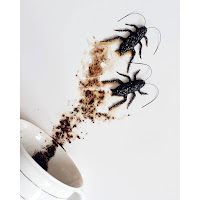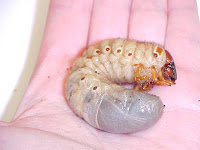It's that time again for finding the perfect gift for the discerning person on your list (or for a good gag gift for the Grinches). Here are some possible arthropod-themed items you may need to pick up.

First up is a spider infused computer mouse. I personally think the whole thing is a bit humorous as I used to have a bird eating tarantula that ate mice and this flips that- a "mouse" with a tarantula inside. ....maybe it's just me that sees that angle? Anyhoo, the website is in Japanese so good luck if you actually want to order one!
http://www.kyeagifts.com/

This next one is actually something that I LOVE! I follow Bloodmilk on
Instagram (bloodmilk) and she has some amazing items. As well as various jewelry items, she has an tote that has two awesome (in my opinion) things on it- spiders and books!
The Comfort of Dust

Another item that I adore calls to my affinity for....yes, you guessed it...COCKROACHES! And sorry folks, but this one is already in (actually on) my greedy little hands, so it's off the market. I had the ring custom made by Amanda Black of
Black Rabbit Studios with a hidden cockroach. She does amazing work and I can't say enough about how beautiful my ring is. She has many other items that are inspired by nature, so check her out!

If you're into real insects, then these beetle earrings may be for you. Made by Insect Art on
Etsy, they will certainly grab people's attention and provide an ice breaker at any holiday parties.

I've been following
coffeetopia's (
Ghidaq al-Nizar) work for awhile. He creates art from coffee grounds and they are stunning! My favorite, of course, had cockroaches!

This paper dragonfly chandelier is would be perfect for a child's room or to add some natural theming to a home. Made by
kismetsunday on etsy. They have dragonflies, butterflies as well as seahorses, leaves, snowflakes, jellyfish, koi and other designs.

Susan Soares is twisting the insect theme with her
insects au gratin line. She 3-D prints (with dried insect powder) items that can be not only used or worn, but eaten! I think this is an interesting concept that creates not only beautiful
works of art, but items that make you think about what can be/
is used as food around the world.
 There are some types of ladybird beetles (a.k.a. ladybugs) that will crawl into cracks and crevices around homes when it gets cold outside. They, like you (or at least me, for sure, since I moved to Texas to get away from snow and long winters), want to seek out a warm spot to hang out on those chilly days. When they discover a route that leads them all the way inside the structure, they can become active due to the temperatures we maintain inside to make ourselves comfortable. This allows the ladybugs to remain active and flying around inside.
There are some types of ladybird beetles (a.k.a. ladybugs) that will crawl into cracks and crevices around homes when it gets cold outside. They, like you (or at least me, for sure, since I moved to Texas to get away from snow and long winters), want to seek out a warm spot to hang out on those chilly days. When they discover a route that leads them all the way inside the structure, they can become active due to the temperatures we maintain inside to make ourselves comfortable. This allows the ladybugs to remain active and flying around inside. 

























